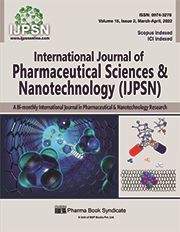Formulation and In-vitro Evaluation of Gliclazide and Nimodipine Bilayer Tablets for the Treatment of Type II Diabetes Mellitus and Hypertension
DOI:
https://doi.org/10.37285/ijpsn.2022.15.3.2Abstract
Background: In today's world, type 2 diabetes mellitus, and hypertension have become universal, and a large number of patients are living with diabetes mellitus and hypertension, which often coexist. The core idea of this study was the development of bilayer tablets collected from two unlike categories of drugs through a straightforward and easy-to-scale-up approach.
Objective: In the present investigation, a bilayer tablet of Gliclazide and Nimodipine was developed to enhance long-suffering patient compliance. The objective of the current investigation was to develop a bilayer dosage form of Gliclazide and Nimodipine for oral route of administration that will liberate Nimodipine immediately and Gliclazide for 12 hrs. to increase the oral bioavailability of the drug.
Methodology: The immediate-release (IR) sheet was developed by a variety of super-disintegrants like Crospovidone, Croscarmellose sodium, and sodium starch glycolate, and the sustained-release (SR) sheet was developed by a variety of polymers like Hydroxy Propyl Methyl Cellulose (HPMC), Hydroxy Propyl Cellulose (HPC), and Eudragit. Initially, the Gliclazide sheet was positioned in the die cavity and compacted. Then Nimodipine sheet was placed in the die cavity and compacted with a most favourable hardness of 6–8 kg/cm2 to get bilayer tablets.
Results and Discussion: The in-vitro drug release of Nimodipine was 97% in 30 minutes and Gliclazide was 98% in 12 hours. The drug release of Gliclazide was only 4.7% in the first 30 minutes; it showed that drug release of Gliclazide was negligible up to 30 minutes. The addition of sodium lauryl sulfate to the (IR) sheet and dissolution medium (SR) improved the drug release from both sheets.
Conclusion: The current research concluded that the selected bilayer tablet was found good to treat diabetes mellitus and hypertension by the chronological release of both drugs from a developed bilayer tablet. Also, this bilayer tablet reduces the dosage frequency.
Downloads
Metrics
Keywords:
Gliclazide, Nimodipine, Bilayer tablet, Diabetes Mellitus, Hypertension, super-disintegrantsDownloads
Published
How to Cite
Issue
Section
References
Agarwal P, Jindal C, Sapakal V (2018). Efficacy and Safety of Teneligliptin in Indian Patients with Inadequately Controlled Type 2 Diabetes Mellitus: A Randomized, Double blind Study. Indian Journal of Endocrinology and Metabolism 22(1): 27-32.
Deshpande RD, Gowda D, Mahammed N and Maramwar D N (2011). Bi-Layer Tablets - An Emerging Trend: A Review. International Journal of Pharmaceutical sciences and research 2(10): 2534-2544.
Godge GR Palwe VD, Pawar PY (2016). Formulation Development and in vitro Evaluationof Sustained Release Tablets of Telmisartan by Solid Dispersion Technology. Asian Journal of Pharmaceutical Technology & Innovation 4(17):13-139.
Gupta CN, Raghavan V, Sen S, Kothari S (2017). Role of teneligliptin in rural India as add-on third drug in patients with type 2 diabetes mellitus. International Journal of Advances in Medicine 4(2):401-405.
Harika CH, Rao YRJ, Gousia Parvin SK, and Sastry SS (2013). Formulation and evaluation of immediate release tablets of Nebivolol Hydrochloride. International Journal of Pharmaceutical Archives 2(11):251–258.
Indian Pharmacopoeia (2014). 7th ed. Worldwide Book Service 3:1215.
Krishna MV, Venkateswara R (2016). Formulation and Evaluation of Multilayered Tablets of Metformin, Telmisartan and Glipizide for the Combination Therapy of Diabetes and Hypertension. World Journal of Pharmacy and Pharmaceutical Sciences 3(11): 1116-1135.
Kumar GH, Jaganathan K, Kumar RS and Peruma P(2012). Formulation and in-vitro evaluation of bilayer floating tablets of Metformin hydrochloride and Sitagliptin phosphate. International Journal of Advanced Pharmaceutics 2(2):64–81.
Maladkar M, Sankar S, Kamat K (2016). Teneligliptin: Heralding Change in Type 2 Diabetes. Journal of Diabetes Mellitus6:113-131.
Patel H, Shah V, Upadhyay U (2011). New Pharmaceutical Excipient in Solid Dosage Forms-A Review. International Journal of Pharmacy and Life Sciences 2(8):1006-1019.
Patil M, Jani HD, Khoja SS, Pirani NA, Khoja SS (2013). A Review on chemistry and pharmacological activity of metformin hydrochloride and teneligliptin hydrobromide hydrate in combined dosage form. WJPPS 5(3) :24-30.
Preethi L, Sree Giri Prasad B and Pranitha R (2014). Formulation and evaluation of immediate release tablets of Nebivolol hydrochloride. Journal of Global Trends in Pharmaceutical Sciences 5(3):1790–1796.
Rangapriya M, Manigandan V, Natarajan R and Mohan Kumar K (2012). Formulation and evaluation of floating tablets of Pioglitazone hydrochloride. International Journal of Pharmaceutical and Chemical Sciences 1:1048–1054.
Ranpise N, Jamkar P, Langote H (2014). Formulation and Development of Fixed Dose Combination of Antihypertensive and Antidiabetic Agent for treatment of Co- existent Type Two Diabetes Mellitus and Hypertension. Indian Journal of Pharmaceutical Education and Research 48:12-18.
Ranpise N, Jamkar P, Langote H (2015). Do Fixed Dose Combinations Play an Important Role in the Management of Coexistent Type Two Diabetes Mellitus and Hypertension? Indian Journal of Pharmaceutical Education and Research 49(3):190-199.
Rohini D, Alexandar S and Chandrasekar MJN (2012). Preparation and in vitro evaluation of sustained release tablet formulations of metformin HCL. Asian Journal of Pharmaceutical and Clinical Research 5(1):45–48.
Shirse P (2012). Formulation and evaluation of bilayered tablets of HP-
Sri HT & Marc SR (2014). DPP-4 inhibitors: focus on safety Expert Opin. Drug Safety. 14(1):13-17.
Sudhakar M, UmeshRao V and Samalla N (2013). Development and optimization of paracetamol immediate release and aceclofenac control release bilayer tablet. American Journal of Advanced Drug Delivery 2:98–103.
Thanda V, Firoz S, Yerram C, Vikram A, Divya SK and Murali KT (2012). Design and characterisation sustained release matrix tablets of Repaglinide using natural polymers. International Journal of Pharmacy 2:73–83.
United States Pharmacopoeia 34 NF 29 (2011). 29th ed. 3:3611–3614.
Vamshi D, Laxmi Madhuri P and Tuljarani G (2013). Method development and validation of indapamide and nebivolol hydrochloride by rp-hplc method. International Journal of Research In Pharmaceutical and Nano Sciences 2(6):798–810.
Venkateswara RS, Rodhay G & Padmalatha K (2017). Design and evaluation of mouth dissolving tablets of telmisartan by using different super-disintegrants. Indo American Journal of Pharmaceutical Research 7(09): 2231-6876.
Venkateswarlu K and Shanthi A (2012). Formulation and evaluation of sustained release glipizide matrix. IOSR Journal of Pharmacy and Biological Sciences 2(5):17–23.
Venugopal K, Mohammed MZ (2014). Prevalence of hypertension in type-2 diabetes Mellitus. CHRISMED Journal of Health and Research 1(4): 223-227.






